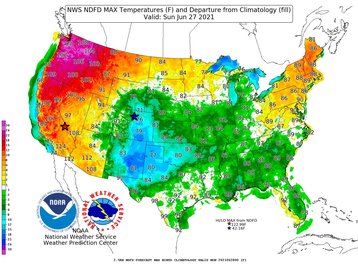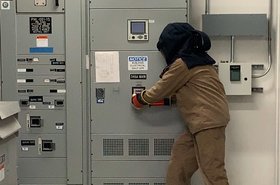A "record-breaking and dangerous heatwave" is set to hit the West Coast of the United States this weekend, the National Weather Service has warned.
A state of emergency has been called in California due to the rising temperatures, which are expected to put significant strain on the grid.
Weeks of record temperatures and a brutal drought have left reservoirs depleted, forcing a hydropower plant to prepare to shut down for the first time in its history.
This month has seen the West suffer two record-breaking heat waves, with a massive high-pressure heat dome building over the region, exacerbating issues further.
Starting this weekend, over 80 sites along the West Coast are expected to break daily high temperature records. All-time June monthly records could also be broken in some locations in the Pacific Northwest, the National Weather Service said.
On June 3, the US Drought Monitor warned of an "exceptional” drought across more than a quarter of the West, including more than half of Utah and Arizona. Nearly 98 percent of the West is seeing some level of drought, as of June 15 - the worst since the Monitor began recording droughts.
Research suggests that the period of 2000-2018 was the worst drought the region has experienced in more than four centuries. The current drought is more than twice as bad.
A broader study of megadroughts found that the West is in the midst of one right now - and it's the worst in at least 1,200 years.
On June 17, Californian governor Gavin Newsom issued a state of emergency over the heat waves (joining a drought emergency since April), adding that the "Extreme Heat Event has and will continue to put significant demand and strain on California's energy grid."
Asking consumers to reduce strain on the grid where possible, he added "it is critical that power plants in the State generate as much power as possible."
However, the Edward Hyatt Power Plant is set to shut down for the first time since it opened in 1967 due to the drought. Northern California's Lake Oroville reservoir, which fuels the 644MW hydropower plant, has seen water levels drop drastically.
Water levels are dropping so fast that it may not be able to operate at all in a few months, just as the now-annual wildfire season kicks up. For now, the Hyatt plant has reduced its capacity by 20 percent, but a shutdown is planned.
California has asked citizens to reduce water consumption, take shorter showers, and fix leaks. Farmers are tearing up crops of water-intensive almonds, despite the state supplying about 80 percent of the nation's almond market.
Lakes, rivers, and streams are now so shallow and hot that they are deadly for endangered Chinook salmon. To save the species, the Department of Fish and Wildlife will truck nearly 17 million young Chinook salmon from four of their hatching locations out to cooler coastal waters.
The arid conditions have also led to a severe grasshopper plague, with the largest grasshopper-killing campaign in decades launched to control rising numbers that could drive up beef and crop prices. Environmentalists have warned that widespread pesticide spraying will kill multiple species, including endangered animals like monarch butterflies, and critical parts of the ecosystem including bees.
The heatwaves and droughts will lead to deaths among those who cannot stay cool, and economic hardship for farmers, fishermen, and other industries reliant on water.
Details on how much water is used by data centers in the West are limited, with facilities relying on different approaches to cooling that require varying amounts of water.
In 2015, a 451 Research report of large data centers found that more than 800 facilities in California consumed as much water annually as 158,000 Olympic-sized swimming pools - around 104,280,000,000 gallons.
The report came out while California was in the fourth year of a severe statewide water shortage.
Some data center firms have invested heavily in reducing water use, or in giving back water in stressed regions, but the industry as a whole is still a huge water consumer. Google, for example, was granted more than 2.3 billion gallons of water for data centers across just three states, Time reports. It is seeking another 1.46 billion gallons in Red Oak, Texas, where droughts are expected. The company is far from alone.
Such heatwaves and droughts are predicted to only get worse in the years ahead as anthropogenic climate change wreaks havoc with the delicately balanced natural system. Greenhouse gas emissions since the Industrial Revolution are raising temperatures globally, threatening every species on Earth, including humans.
A draft report from the United Nations' Intergovernmental Panel on Climate Change this week said that "climate change will fundamentally reshape life on Earth in the coming decades, even if humans can tame planet-warming greenhouse gas emissions."
Several tipping points - including the melting of polar ice sheets, and the Amazon rainforest switching to savannah - would lead to a series of cascading events that would cause further emissions releases.
“Life on Earth can recover from a drastic climate shift by evolving into new species and creating new ecosystems … humans cannot," the report said.
An Uptime Institute study last year found that 26 percent of North American-based data center managers believe that while climate change is occurring, it is not caused by human activity. A further four percent do not believe that climate change is happening at all.



